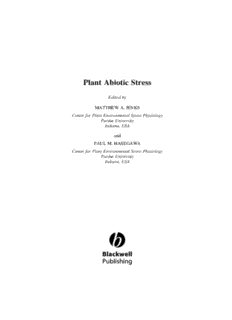
plant abiotic stress.pdf - ResearchGate PDF
Preview plant abiotic stress.pdf - ResearchGate
Plant Abiotic Stress Edited by MATTHEW A. JENKS Center for Plant Environmental Stress Physiology Purdue University Indiana, USA and PAUL M. HASEGAWA Center for Plant Environmental Stress Physiology Purdue University Indiana, USA Plant Abiotic Stress Biological Sciences Series A series which provides an accessible source of information at research and professional levelinchosensectorsofthebiologicalsciences. SeriesEditor: Professor J. A. Roberts, Plant Science Division, School of Biosciences, University of Nottingham,UK. Titlesintheseries: BiologyofFarmedFish EditedbyK.D.BlackandA.D.Pickering StressPhysiologyinAnimals EditedbyP.H.M.Balm SeedTechnologyanditsBiologicalBasis EditedbyM.BlackandJ.D.Bewley LeafDevelopmentandCanopyGrowth EditedbyB.MarshallandJ.A.Roberts EnvironmentalImpactsofAquaculture EditedbyK.D.Black HerbicidesandtheirMechanismsofAction EditedbyA.H.CobbandR.C.Kirkwood ThePlantCellCycleanditsInterfaces EditedbyD.Francis MeristematicTissuesinPlantGrowthandDevelopment EditedbyM.T.McManusandB.E.Veit FruitQualityanditsBiologicalBasis EditedbyM.Knee PectinsandtheirManipulation EditedbyG.B.SeymourandJ.P.Knox WoodQualityanditsBiologicalBasis EditedbyJ.R.BarnettandG.Jeronimidis PlantMolecularBreeding EditedbyH.J.Newbury BiogeochemistryofMarineSystems EditedbyK.D.BlackandG.Shimmield ProgrammedCellDeathinPlants EditedbyJ.Gray WaterUseEfficiencyinPlantBiology EditedbyM.A.Bacon PlantLipids–Biology,UtilisationandManipulation EditedbyD.J.Murphy PlantNutritionalGenomics EditedbyM.R.BroadleyandP.J.White PlantAbioticStress EditedbyM.A.JenksandP.M.Hasegawa Plant Abiotic Stress Edited by MATTHEW A. JENKS Center for Plant Environmental Stress Physiology Purdue University Indiana, USA and PAUL M. HASEGAWA Center for Plant Environmental Stress Physiology Purdue University Indiana, USA (cid:2)2005byBlackwellPublishingLtd EditorialOffices: BlackwellPublishingLtd,9600GarsingtonRoad,OxfordOX42DQ,UK Tel:þ44(0)1865776868 BlackwellPublishingProfessional,2121StateAvenue,Ames,Iowa50014-8300,USA Tel:þ15152920140 BlackwellPublishingAsiaPtyLtd,550SwanstonStreet,Carlton,Victoria3053,Australia Tel:þ61(0)383591011 TherightoftheAuthortobeidentifiedastheAuthorofthisWorkhasbeenassertedin accordancewiththeCopyright,DesignsandPatentsAct1988. Allrightsreserved.Nopartofthispublicationmaybereproduced,storedinaretrieval system,ortransmitted,inanyformorbyanymeans,electronic,mechanical,photocopying, recordingorotherwise,exceptaspermittedbytheUKCopyright,DesignsandPatents Act1988,withoutthepriorpermissionofthepublisher. Firstpublished2005byBlackwellPublishingLtd LibraryofCongressCataloging-in-PublicationData Plantabioticstress/editedbyMatthewA.JenksandPaulM.Hasegawa.–1sted. p.cm. Includesbibliographicalreferencesandindex. ISBN-10:1-4051-2238-2(hardback:alk.paper) ISBN-13:978-1-4051-2238-2(hardback:alk.paper) 1.Crops–Effectofstresson.2.Crops–Physiology.I.Jenks,MatthewA.II.Hasegawa,PaulM. SB112.5.P52005 632’.1–dc22 2004025753 ISBN-10:1-4051-2238-2 ISBN-13:978-14051-2238-2 BritishLibraryCataloguing-in-PublicationData AcataloguerecordforthistitleisavailablefromtheBritishLibrary Setin10.5/12ptTimesNewRoman byKolamInformationServicesPvt.Ltd,Pondicherry,India PrintedandboundinIndia byGopsonsPapersLtd,Noida Thepublisher’spolicyistousepermanentpaperfrommillsthatoperateasustainable forestrypolicy,andwhichhasbeenmanufacturedfrompulpprocessedusingacid-freeand elementarychlorine-freepractices.Furthermore,thepublisherensuresthatthetextpaper andcoverboardusedhavemetacceptableenvironmentalaccreditationstandards. ForfurtherinformationonBlackwellPublishing,visitourwebsite: www.blackwellpublishing.com Contents Contributors xi Preface xvi 1 Eco-physiological adaptations tolimitedwater environments 1 ANDREW J. WOOD 1.1 Introduction 1 1.2 Limited water environments 2 1.2.1 Arid and semiaridregionsof the world 2 1.2.2 Plantstrategies for water economy 4 1.2.3 Ability tosurvive inwater-limited environments 5 1.2.4 Survivingwater-deficit(drought) andsevere water-deficit(desiccation) 6 1.3 Adaptationto limited water environments 7 1.3.1 Evolution of land plants 7 1.3.2 Tolerancetodesiccation 10 1.4 Refresher of the world – how to create more drought-tolerant crops 10 2 Plant cuticlefunctionas a barrier towater loss 14 S. MARKGOODWIN and MATTHEW A. JENKS 2.1 Introduction 14 2.2 Cuticle structure andcomposition 14 2.3 Cuticle functionas a barrier toplant water loss 18 2.4 Genetics of cuticle permeability 24 2.5 Conclusions 31 3 Plant adaptiveresponses tosalinitystress 37 MIGUEL A.BOTELLA, ABELROSADO, RAY A.BRESSAN and PAUL M. HASEGAWA 3.1 Saltstress effects on plantsurvival, growth and development 37 3.1.1 NaCl causes both ionic andosmoticstresses 38 3.1.2 Secondary effects ofsaltstress 38 vi CONTENTS 3.2 Plant genetic models for dissection ofsalt tolerance mechanismsand determinantfunction 39 3.2.1 Arabidopsisthaliana asa model for glycophyte responses to salt stress 40 3.2.2 Thellungiellahalophila (salt cress) – a halophyte moleculargenetic model 40 3.3 Plant adaptationsto NaCl stress 41 3.3.1 Intracellularionhomeostatic processes 41 3.3.1.1 Naþ influx and efflux acrossthe plasma membrane 42 þ (cid:2) 3.3.1.2 Na andCl compartmentalization intothe vacuole 42 3.3.1.3 Kþ=Naþ selective accumulation 44 3.3.2 Regulation of Naþ homeostasisin rootsand shoots 44 3.3.3 Sensing and regulatory pathways that control ion homeostasis 45 3.3.4 Osmotic homeostasis: compatible osmolytes 46 3.3.5 Damageresponse and antioxidant protection 46 3.4 Plant salt tolerance determinants identifiedby functional genetic approaches 47 3.4.1 Effectorgenes 52 þ 3.4.1.1 Na homeostasis 52 3.4.1.2 Genes involved in osmotic homeostasis: synthesis ofcompatible solutes 54 3.4.1.3 Genes involved in ROS scavenging 54 3.4.1.4 Genes involved in protectionofcell integrity 56 3.4.2 Regulatorygenes 56 3.4.2.1 Kinases 56 3.4.2.2 Transcriptionfactors 57 3.4.2.3 Other salt tolerance determinants 58 3.5 Global analysisof transcriptional activationof salt-responsive genes 58 4 The CBF cold-responsepathway 71 SARAHFOWLER, DANIEL COOK and MICHAEL F.THOMASHOW 4.1 Introduction 71 4.2 ArabidopsisCBF cold-responsepathway 72 4.2.1 Discovery andoverview 72 4.2.2 CBFproteins 75 4.2.2.1 Generalproperties 75 4.2.2.2 Mechanism ofaction 76 CONTENTS vii 4.2.3 Function ofthe CBF cold-response pathway 78 4.2.3.1 Cryoprotective proteins 79 4.2.3.2 Regulatoryproteins 81 4.2.3.3 Biosynthetic proteins 82 4.2.4 Regulation of CBFgene expression inresponse tolow temperature 83 4.2.4.1 DNA regulatoryelements controllingCBF expression 84 4.2.4.2 Proteins with positiverolesinCBF expression 84 4.2.4.3 Proteins with negative roles inCBFexpression 85 4.2.4.4 Other potential CBFregulatoryproteins 87 4.2.4.5 Light andcircadianrhythms 87 4.2.4.6 Role of calcium 88 4.2.4.7 Role of ABA 89 4.3 Conservationof the CBFcold-response pathway 89 4.3.1 Brassica napus 89 4.3.2 Tomato 90 4.3.3 Rice 92 4.4 Concludingremarks 93 5 Plant responsesto hightemperature 100 JANE LARKINDALE,MICHAEL MISHKINDand ELIZABETH VIERLING 5.1 Introduction 100 5.2 Physiological responses tohightemperature 101 5.2.1 Hightemperature limits tooptimal plant performance 101 5.2.2 Heat sensitivity of photosynthesis 102 5.2.3 Heat sensitivity of reproduction 104 5.3 Cellular acquiredthermotolerance 104 5.4 Heat shock proteins/molecularchaperones 105 5.4.1 Hsp100/ClpB 106 5.4.2 Hsp90 110 5.4.3 Hsp70/DnaK 111 5.4.4 Hsp60/GroE 111 5.4.5 ThesHSP family ofproteins 112 5.5 Other components ofthe response toheat 114 5.5.1 Antioxidantproduction 115 5.5.2 Other heat-stressregulatedgenes 118 5.5.3 Other heat-protective responses 120 5.5.4 Mutants defective inheat tolerance 121 5.5.5 Transgenicplantswith alteredheat tolerance 122 viii CONTENTS 5.6 Signaling pathways involved in response toheat 125 5.6.1 Heat shock transcription factors 125 5.6.2 Other signaling pathways 126 5.6.3 Abscisic acid 126 5.6.4 Salicylic acid 127 5.6.5 Calcium 127 5.6.6 Active oxygen species 128 5.6.7 Ethylene 128 5.6.8 Signaling lipids 129 5.6.9 Kinases and phosphatases 129 5.7 Genetic variation in heat tolerance 131 5.7.1 Agricultural/horticultural plants 131 5.7.2 Natural variationinheattolerance 132 5.8 Summary 132 6 Adaptive responses inplantsto nonoptimal soilpH 145 V. RAMI´REZ-RODRI´GUEZ,J. LO´PEZ-BUCIOand L. HERRERA-ESTRELLA 6.1 Introduction 145 6.2 Soil pH 146 6.3 Soil acidification 146 6.4 Acid soils 147 6.5 Calcareoussoils 148 6.6 Plantresponses to soilstress 149 6.7 Plantresponses to heavy metals 150 6.8 Aluminum tolerance by exclusion 150 6.9 Aluminum tolerance by internal accumulation 152 6.10 Metal hyperaccumulators 153 6.11 Plant responses to mineral deficiency 155 6.11.1 Phosphorusdeficiency 155 6.11.2 Improving P efficiencyin transgenic plants 156 6.11.3 Plantresponses toirondeficiency 158 6.12 Morphological responses to mineral deficiency 161 6.12.1 Effects ofironavailability on transfer cell formation 161 6.12.2 Effects ofnutrientavailability on root hairformation 162 6.12.3 Effects ofnutrientavailability on root branching 162 6.13 Functionalgenomics for the discovery ofgenes involvedin mineral nutrition 163 6.14 Applicationoffunctionalgenomics toiron and phosphorus nutrition 164
Description: